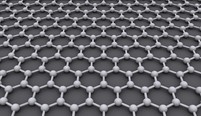Extra boost for graphene research
26. November 2015
über
über

New funding for projects of FOM scientists
Thirteen international teams of scientists have received a total of 9.9 milion euros from FLAG-ERA, the European Flagship ERA-NET, for research in the area of graphene. FOM is funding three of the projects of Dutch researchers: FOM workgroup leaders Bart van Wees (University of Groningen) and Rob Lammertink (University of Twente), as well as researcher Kees Flipse (Eindhoven University of Technology).
Flipse and Van Wees are receiving funding for projects in the 'Tailoring spin-interactions in graphene nanoribbons for ballistic fully spin-polarized devices' (TAILSPIN) consortium. Lammertink has been awarded funding for a project in the 'Nanofluidics and Ultrafiltration with Track Etched Graphene-Polymer-Composite Membranes' (NU-TEGRAM) consortium. The total contribution of the FOM Foundation to these three projects within the ERA-NET is 782,000 euros.
The two consortia:
TAILSPIN: optimal manipulation of spin interactions in a graphene nanoribbon in order to develop devices with ballistic and fully spin-polarised charge transport
Five groups are collaborating in this European consortium: two in Germany, one in Sweden and the groups of Bart van Wees (University of Groningen) and Kees Flipse (Eindhoven University of Technology) in the Netherlands. The aim of combining the expertise of the groups is to develop a new spin-polarised switching quantum device. The researchers want to realise this by manipulating epitaxial graphene via fundamental research, matching the electron structure and ultimately controlling the growth of nanoribbons at the atomic scale. With this financial support, both Dutch groups can each appoint a PhD student for a period of four years.
NU-TEGRAM
Nanofluidics and ultrafiltration using perforated graphene-polymer composite membranes
This consortium has five partners: two in Germany, one in France, one in Croatia and one in the Netherlands – the group led by Rob Lammertink (University of Twente). The main aim of this project is to study the transport of liquids through perforated graphene layers. The researchers aim to develop graphene-polymer composites that are exposed to specific etching processes. With this platform, they can study transport through these graphene layers, which should ultimately form the basis for the development of ultrafiltration and ion-selective nanofiltration membranes. The Dutch group can appoint a PhD student who will study the transport mechanisms of liquids through these perforated graphene layers.
FLAG-ERA is the European ERA-NET of funding agencies that supports the two FET Flagships: Graphene and Human Brain Project. In the autumn of 2014, FLAG-ERA organised a transnational call. The input of FOM in this call contributes to the NWO effort for the top sector High Tech Systems and Materials (HTSM). The subjects from the call for graphene awarded funding are complementary to the research within the Graphene FET Flagship. The aim is to facilitate the nationally funded research.
Further information
NWO programme page FLAG-ERA
Press release FLAG-ERA
Contact
Paula van Tijn
Thirteen international teams of scientists have received a total of 9.9 milion euros from FLAG-ERA, the European Flagship ERA-NET, for research in the area of graphene. FOM is funding three of the projects of Dutch researchers: FOM workgroup leaders Bart van Wees (University of Groningen) and Rob Lammertink (University of Twente), as well as researcher Kees Flipse (Eindhoven University of Technology).
Flipse and Van Wees are receiving funding for projects in the 'Tailoring spin-interactions in graphene nanoribbons for ballistic fully spin-polarized devices' (TAILSPIN) consortium. Lammertink has been awarded funding for a project in the 'Nanofluidics and Ultrafiltration with Track Etched Graphene-Polymer-Composite Membranes' (NU-TEGRAM) consortium. The total contribution of the FOM Foundation to these three projects within the ERA-NET is 782,000 euros.
The two consortia:
TAILSPIN: optimal manipulation of spin interactions in a graphene nanoribbon in order to develop devices with ballistic and fully spin-polarised charge transport
Five groups are collaborating in this European consortium: two in Germany, one in Sweden and the groups of Bart van Wees (University of Groningen) and Kees Flipse (Eindhoven University of Technology) in the Netherlands. The aim of combining the expertise of the groups is to develop a new spin-polarised switching quantum device. The researchers want to realise this by manipulating epitaxial graphene via fundamental research, matching the electron structure and ultimately controlling the growth of nanoribbons at the atomic scale. With this financial support, both Dutch groups can each appoint a PhD student for a period of four years.
NU-TEGRAM
Nanofluidics and ultrafiltration using perforated graphene-polymer composite membranes
This consortium has five partners: two in Germany, one in France, one in Croatia and one in the Netherlands – the group led by Rob Lammertink (University of Twente). The main aim of this project is to study the transport of liquids through perforated graphene layers. The researchers aim to develop graphene-polymer composites that are exposed to specific etching processes. With this platform, they can study transport through these graphene layers, which should ultimately form the basis for the development of ultrafiltration and ion-selective nanofiltration membranes. The Dutch group can appoint a PhD student who will study the transport mechanisms of liquids through these perforated graphene layers.
FLAG-ERA is the European ERA-NET of funding agencies that supports the two FET Flagships: Graphene and Human Brain Project. In the autumn of 2014, FLAG-ERA organised a transnational call. The input of FOM in this call contributes to the NWO effort for the top sector High Tech Systems and Materials (HTSM). The subjects from the call for graphene awarded funding are complementary to the research within the Graphene FET Flagship. The aim is to facilitate the nationally funded research.
Further information
NWO programme page FLAG-ERA
Press release FLAG-ERA
Contact
Paula van Tijn
Mehr anzeigen
Weniger anzeigen


Diskussion (0 Kommentare)